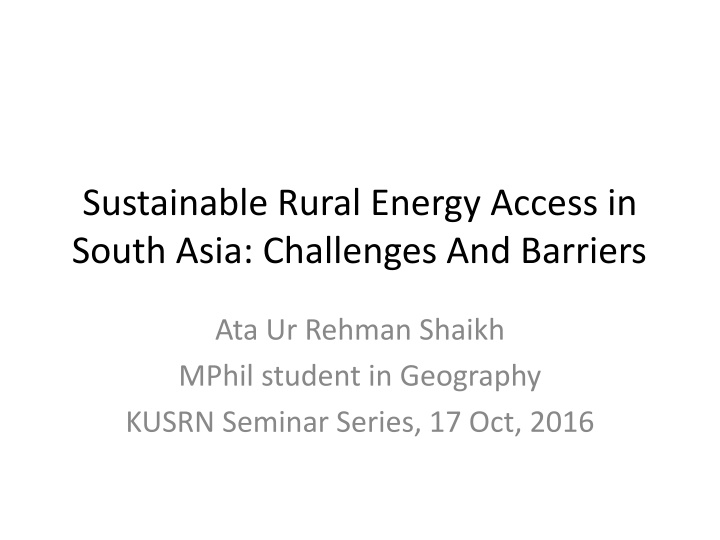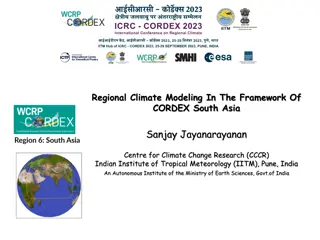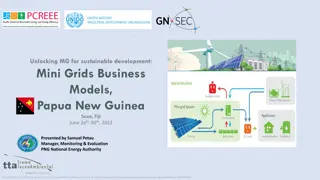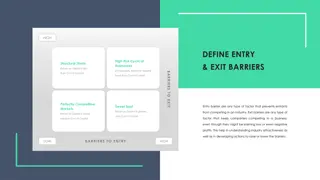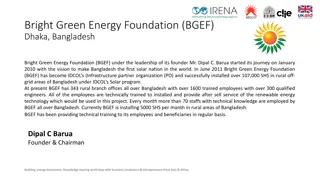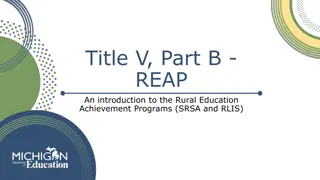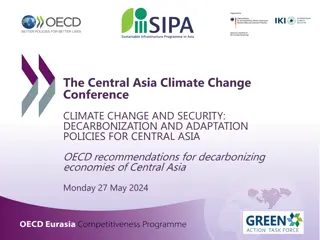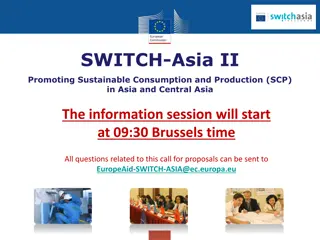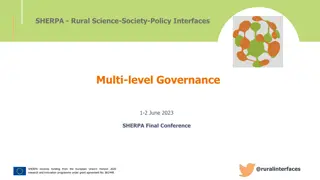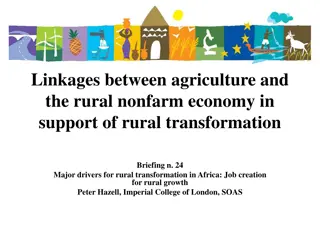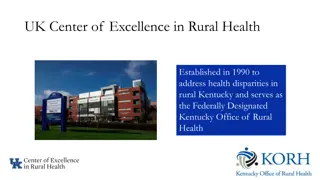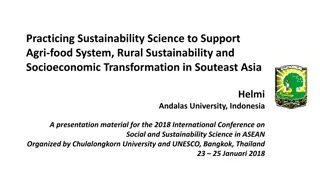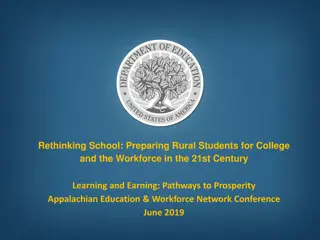Sustainable Rural Energy Access in South Asia: Challenges and Barriers
This research delves into the barriers faced in delivering energy access in rural South Asia, exploring the importance of modern energy services and decentralized renewable energy systems. The study aims to identify major themes and implications and compares peer-reviewed and grey literature to assess their usefulness to DRES practitioners.
Download Presentation

Please find below an Image/Link to download the presentation.
The content on the website is provided AS IS for your information and personal use only. It may not be sold, licensed, or shared on other websites without obtaining consent from the author.If you encounter any issues during the download, it is possible that the publisher has removed the file from their server.
You are allowed to download the files provided on this website for personal or commercial use, subject to the condition that they are used lawfully. All files are the property of their respective owners.
The content on the website is provided AS IS for your information and personal use only. It may not be sold, licensed, or shared on other websites without obtaining consent from the author.
E N D
Presentation Transcript
Sustainable Rural Energy Access in South Asia: Challenges And Barriers Ata Ur Rehman Shaikh MPhil student in Geography KUSRN Seminar Series, 17 Oct, 2016
OUTLINE What was the research about? Why was there a need for this research? Methodology and method used Findings and conclusions Implications of the study
Some Definitions Modern energy services refers to the benefits derived from using energy sources such as lighting, heating, cooking, motive power, mechanical power, transport and, telecommunications. Modern energy sources can include electricity, gas, LPG, efficient use of biomass etc. (Barnes et al. 2011) The term energy access has been used to refer to energy for lighting and cooking (Bhattacharyya 2006a) but this definition has been extended to include access to electricity and modern cooking energies such as gas, efficient use of biomass etc.
Some Definitions The term Decentralized Renewable Energy Systems (DRES) refers to systems that are used to deliver: 1. Electricity from Renewable energy technologies such as photovoltaics, small hydel plants, small wind turbines etc. 2. Clean energy for cooking and space heating from improved cooking stoves, solar cookers, biomass gasification plants, biogas plants etc.
Objectives of the research To systematically review and analyse the barriers to DRES in South Asia in peer-reviewed and grey literature to discover major themes and implications; To perform a comparative analysis of the content and practical impact of both types of literatures to discover main characteristics and qualities of the two sources and the implications to their usefulness to DRES practitioners.
Introduction and background The positive role of access to modern energy services in the socio-economic development of human society is undeniable and research shows that access to energy sources such as oil, gas and electricity plays an important role in the economic growth of developing countries (Soytas & Sari 2006; Yuan et al. 2008; Fondja Wandji 2013) There is also evidence that there is a direct and positive correlation between electricity (one form of energy) consumption per capita and GDP per capita (Kanagawa & Nakata 2008)
Energy consumption Global energy consumption of fossil fuels (coal, oil & gas) has more than doubled in a span of four decades and it is estimated to double again by 2030 (IEA 2015a). (IEA 2015b)
Background Almost 1.3 billion people worldwide, do not have access to electricity and 2.7 billion rely on unsustainable use of traditional fuels (IEA 2011) Traditional fuels refers to the use of fuels such as wood, dung, agriculture residues, candles, kerosene with low efficiencies (Barnes et al. 2011). They are the opposite of clean cooking energies which are based on efficient use of biomass, solar cookers etc.
Traditional Fuels Biomass such as firewood, crop residues, dung etc., still stands as the major source of energy for poor households for cooking and heating in developing countries (Bensch et al. 2015) 72% of total global renewable energy production comes from biomass which is primarily used for heating and cooking (Kumar et al. 2010) Over 90% of the rural population in Bangladesh relies on biomass to meet part of their energy requirements (Rofiqul Islam et al. 2008)
Indoor pollution Traditional fuels are often used in inefficient home- made stoves which is the cause of 4.3 million premature deaths (more than TB, malaria, HIV/AIDS combined) due to smoke inhalation (World Bank 2015)
Background The developing world is worst affected by energy poverty with rural areas in South Asian and Sub-Saharan African countries comprising 80% of people who do not have access to modern energy service (Saghir 2005) In 2005, India alone contained 25% of the global population without access to electricity and more than 30% of global population without access to clean cooking sources (Balachandra 2011) Energy poverty is the lack of access to modern energy resources mainly electricity and refers to the bare minimum energy sources needed to survive (Barnes et al. 2011)
South Asia Per energy consumption (kWh) 13,361 capita Country USA France 7756 Germany 7217 China 2942 Turkey 2474 India 644 Sri Lanka 636 Pakistan 457 Nepal 454 Bangladesh 278
Rural Electricity Access in South Asia Electrification rate (%) Population without electricity (millions) Country 2013 Urban Rural Total Bangladesh 60 90.2 29 41 India 237 96 74 81 Nepal 7 97 71.3 76.3 Pakistan 50 90.6 61.9 72.8 Sri Lanka 1 98.6 92.9 94 (Kumar et al. 2010)
Advantages of energy access Rural communities not only witness an improvement in quality of life from reliable energy access but rural electrification can support refrigeration in clinics, education equipment such as computers and televisions in schools, communication, and simple entertainment systems (World Bank 2008) Access to modern forms of energy like electricity also has potential for revenue generating activities for a rural population like irrigation for better crop yield, food preservation, crop processing, cooling and small- scale industries which help to raise the living standard of the local people (Kanase-Patil et al. 2010).
Decentralized energy Almost all countries in the world rely on a centralized power production and distribution system through a national grid (infrastructure of wires and electrical equipment) and this centralized system has been mainly perpetuated by advantage of economies of scale (Yazdanie et al. 2016) This centralized system of electricity delivery is mostly based on fossil fuel resources causing environmental degradation due to greenhouse gas emissions (Hiremath et al. 2011) Grid extension to rural regions in developing countries is often impractical due to high costs caused by low load factors, low population and scattered and remote regions (Mohammed et al. 2014).
Decentralized energy Decentralized Renewable Energy Systems (DRES) are not connected to the main grid and they harness energy in proximity of its intended area of consumption. They are seen as capable of providing affordable and clean energy access to remote rural populations (Sharma 2007; World Bank 2008; Kaundinya et al. 2009; Kanase-Patil et al. 2010; Clemens et al. 2010; Narula et al. 2012; World Bank 2014; Schnitzar et al. 2014). Other terminologies that have been used to refer to DRES in the literature are Decentralized Distributed Generation (DDG), decentralized generation technologies (DGT) (Yazdanie et al. 2016), Distributed Renewable energy (DRE) (REN21 2016) or Decentralized Energy Planning (DEP) (Hiremath et al. 2009).
Decentralized Renewable Energy Systems The term Decentralized Renewable Energy Systems (DRES) refers to systems that are used to deliver: Electricity from Renewable energy technologies such as photovoltaics, small hydel plants, small wind turbines etc. Clean energy for cooking and space heating from improved cooking stoves, solar cookers, biomass gasification plants, biogas plants etc.
Solar Home Systems Major types of Solar Home Systems installed by Grameen Shakti (Alam et al. 2003)
An analysis of literature on barriers to DRES in South Asia has been carried out. This study will analyse peer reviewed and grey literature discussing barriers to DRES in five countries in South Asia namely, Bangladesh, India, Nepal, Pakistan, and Sri Lanka These countries were chosen for the study with the intent of capturing a broad range of development in DRES and energy conditions in the South Asian region.
Objectives of the research To systematically review and analyse the barriers to DRES in South Asia in peer-reviewed and grey literature to discover major themes and implications; To perform a comparative analysis of the content and practical impact of both types of literatures to discover main characteristics and qualities of the two sources and the implications to their usefulness to DRES practitioners.
Content analysis Content analysis is a research method which utilizes all forms of communication including written text (Marshall 1999) Any technique for making inferences objectively and systematically identifying specified characteristic of messages (Holsti 1969) A research technique for making replicable and valid inferences from texts (and other meaningful matter) in the contexts of their use (Krippendorff 2013) A method that employs a specific set of steps to deduce information that is not otherwise apparent in the text (Weber 1990)
Findings Barrier Title Definition This section contains the barriers to Decentralized renewable energy systems (DRES) associated with organized entities such as government organisations, power utilities responsible for rural electrification, NGOs, etc. Institutional barriers 1 Legal and regulatory barriers Monetary barriers This section discusses all challenges associated with policy and regulations 2 3 This section discusses some of the financial reason Social and People related barriers These are the barriers associated with the people, mainly rural communities utilizing DRES. 4 Technological barriers 5 Technical barriers include site specificity of some DRES
Findings: Institutional barriers Institutional barriers Implications Action Performance monitoring, maintenance plans and access to spares & repair service Capacity development, repository & rural information access points Lack of maintenance Short life of projects Lack awareness of knowledge Lack of promotions and demonstrations Low confidence in DRES
Findings: Policy and regulatory barriers Policy and regulatory barriers Implications Action Policies that are based on resource assessment and user centric Low private investment in DRES due to lack of commercialization and market of DRES Detailed policies that specifically address DRES like mini-grids, improved cooking stoves etc. Ineffective and inadequate policies and regulatory framework for DRES Lack of guidance on DRES operation Low incentive for private DRES developer Market and commercial oriented policies for DRES that encourage and protect private investment Low dissemination of DRES
Findings: Monetary barriers Monetary barriers High initial costs & small market size Implications of Actions Lack production Lack of demand indigenous Research development for low cost and solutions Marketing promotion of DRES and practical Weak supply base Low demand / Lack of awareness / Low financial incentives Low investments in DRES and Lack of dedicated entities for financing developers Low load factors Dedicated institutions for DRES financing DRES Financial viability is absent Research and development for low cost and solutions, activities practical productive
Findings: Monetary barriers SOCIAL BARRIERS Implications Actions Low income & poverty Low purchase power of user Reluctance of investments by de Micro-financing Develop productive uses of DRES Lack of knowledge of benefits, funding sources, cost effectiveness DRES Resistance technology Low investments in DRES demand and Effective promotions demonstrations and for to new Lack of demonstration and pilot projects Effective promotions demonstrations Community in Develop productive uses of DRES and Lack of productive use for revenue generation Low incentive for adopting DRES
Findings: Technological barriers Technological barriers Implications Actions Lack of confidence in DRES use Selection of appropriate and practical technology based on resource availability, Hybrid solutions Hybrid solutions, Investment in DRES research: reducing cost, indigenous design, technical standards, renewable energy data Intermittency of DRES Storage requirement is expensive High cost of equipment
Interdisciplinary Interrelated barriers Difficult to categorise
Sustainable Rural Energy Access A concept of sustainable rural energy access is introduced which refers to the sustainability of all the different dimensions in rural energy access projects The perceived potential for a system or project to endure, build a self-perpetuating capacity within a community, and ultimately reach the end of its predetermined life span or evolve into another beneficial form . (Louie et al. 2014) pg. 71 In the context of this study adding renewable cooking energy, sustainable rural energy access is viewed as the capability of decentralized renewable energy (DRES) systems to continually generate electricity and clean cooking energy for the intended households within the rural community, over the lifespan of DRES.
Sustainable Rural energy access: Conceptual Model Plan: User centric, demand based planning Reflect: Analyse results to identify area of improvement, including community involvement in evaluations Act: Implementation as per plan, involving local community in implementation Monitor: Measure performance against sustainability indicators
Research To Practice Distinct topics such as grid & off-grid, individual home systems & mini-grids, and rural &, were often found not treated differently in both grey and peer-reviewed literature Grey literature was often based on primary research and relied on actual experiences whereas peer-reviewed literature often relied on secondary sources Few peer-reviewed papers discuss specific and real-world examples of barriers and challenges of DRES. There was a predominant use of abstract and high level concepts in peer-reviewed literature to discuss barriers. Grey literature used more simple and specific language with details to explain barriers. Same examples of DRES project failures and challenges are quoted by different authors over a period of several years.
This study suggests that academic resources such as peer reviewed papers in the attempt of providing a guideline to successful implementation of DRES by highlighting specific barriers are grossly inadequate in quantity and quality. There is a lack of focus on actual case studies and field research and there is a gap between the academic world of researchers and NGOs, private entrepreneurs, funders like IEA and World Bank.
Research To Practice Evidence of the gap between research and practice is also found in two very different disciplines, that of accounting (Inanga & Schneider 2005) and medicine (Bero et al. 1998)
Without bringing together all stakeholders into an interactive session, queries and concerns of stakeholders cannot be answered Methodologies such as participatory action research can potentially solve this gap and assert that the understanding and improvement of practice strongly depends on inquiry and practice In participatory action research cases, practitioners are viewed as contributors in generation of knowledge and not only recipients (Stevenson 2004). Sustainable rural energy access can benefit from knowledge generated by participative action which will enable viewing the problem from different perspectives. Studying with people and not studying people can yield practical real-world solutions Bradbury (2003)
References IEA, 2015b Key World Energy Statistics
